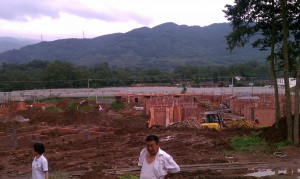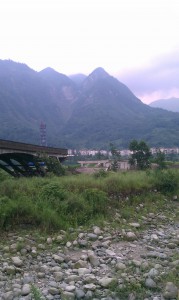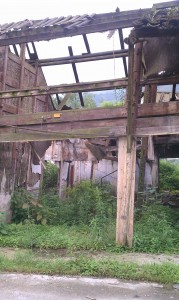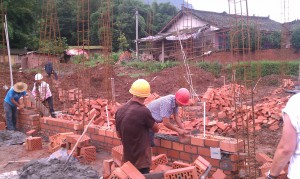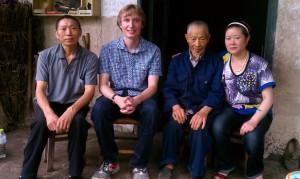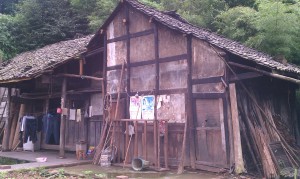By NICHOLAS KREBS, 7/10/2012. My attempt to write one post dealing with my Chengdu experience and my Habitat experience has failed, so I’m breaking them up into pieces to get it all out there. And to think I haven’t even started on my current location of Xi’an yet!
These are some of my guiding project questions for Habitat for Humanity in Sichuan province. The preliminary answers have been gathered through an interview with Jane Li, Government Relations and Resources Development Manager at the Sichuan branch of Habitat for Humanity China and visits to three different project sites that serve earthquake survivors of the province. This is an initial write-up with some additional fact-checking to be done, so please use this information only as insight to what I’ve been working on so far in China, and not as gospel :)
1. Where does Habitat build in Sichuan province?
After the 2008 earthquake in Sichuan province, Habitat for Humanity has been engaged with 10 different rebuilding projects in the earthquake zone and helped build or fix 1,700 houses in the area. While I took notes on this during the interview, the Habitat China website provides a much better write-up than my attempt:
“In May 2008, Sichuan experienced an 8.0 magnitude earthquake that killed approximately 90,000 people. Over 1.5 million people lived in the affected area with 3,476,000 houses destroyed or damaged according to government statistics. 1,263,000 houses are in need of complete reconstruction and 2,213,000 are in need of repair. Some of the families hardest hit were those living in poverty in rural areas.
Habitat for Humanity China began its operation in Sichuan province in 2008 in response to the devastating earthquake. To date, HFH China has built 1,400 houses in ten villages in the townships of Xioayudong, Bailu, Jiexing, Zhuyuan and Qionglai working in partnership with the local government.
These houses, which include single detached, row houses, townhouses and apartment buildings, were all built using the government’s quality standard for earthquake resistant housing and designs from the Architecture Design Institute in Chengdu from which the families could choose. In an effort to increase income generation for the families affected by the earthquake, many of whom lost their farm land because of the disaster, 297 of the houses were constructed with livelihood in mind. In Taizi and Yangping villages, houses were built as bed and breakfasts to accommodate the many tourists that visit the area. The houses in Luoyang and Changzhen villages were constructed so that the families would have space for a small business on the ground floor and could live comfortably above.
Habitat for Humanity’s approach to community development in China is holistic, accounting not only for the homes of families, but the education of children as well. In Zhuyan township, Qingchuan county, Habitat is building ten apartment buildings, which will house 236 families, as well as a nursery school to help replace the more than 7,000 classrooms that were lost during the earthquake.”
(http://www.habitatchina.org/eng/built_chinaprojects?i=21)
2. How do volunteers participate in the Habitat builds?
The volunteers come from many sources, from high school students and professionals across China looking to do service to help their country, to Global Village builds that are organized by Habitat to bring disparate volunteers from around the world to work together on local construction sites. In Sichuan, the volunteers are primarily doing a lot of the heavy lifting for seasoned construction workers. This means that they carry bricks from one worksite to the next, clear areas of debris, and assist with farming and landscaping tasks in a particular village. They don’t do the primary bricklaying of the houses, as the houses must be built to a strict standard in order to withstand future high magnitude earthquakes. For the most part the volunteers take it in stride, knowing that they save the construction workers valuable time as they prepare worksites for bricklaying and other construction.
3. Which families receive houses from Habitat for Humanity?
In the case of the Sichuan Habitat office, families who are selected for the program had their homes destroyed or severely damaged by the 2008 earthquake and have applied for a new Habitat home. Additionally, even if their home is intact, they may be chosen to participate as part of a land swap with the government, to encourage them to move closer to a centralized village where electricity, gas and sewer services can be provided.
To participate, they must have some savings to contribute to the construction of the house, but they also receive subsidies of 15,000 yuan from the government and also an additional 15,000 yuan per family member from the Habitat office. These subsidies are not paid in a lump sum, but are sort of like matching grants to the family once they achieve certain milestones for home construction, such as the foundation being laid on the house. Once a milestone is achieved, the family receives the next portion of the subsidy.
For families that need additional funds beyond the Habitat and government subsidies, they would apply for a mortgage from a local bank that provides a 3-5 year mortgage for the gap financing. I was quite shocked to learn how short the loan repayment terms were! In the United States most mortgages have small down payments and 15-30 year terms. This likely has a lot to do with the sky-high savings rate in China and the terrible savings rate in the United States.
4. How much do the new homes cost?
On average, the building cost for each house is 900 yuan per cubic meter. China has regulations for new buildings that require each family have 30 cubic meters of space for each occupant, so the cost runs around 27,000 yuan per occupant in a family. Given that most families have 3-5 members, the average cost of a new Habitat one family house is about 120,000 yuan. This is about $20,000 US dollars and is considered quite expensive for the region due to the materials used in construction and the tight earthquake building standards.
5. What style are the houses built in? What materials are used?
The new houses are very simple structures and are standalone brick one-family homes. While brick is the primary building material, the important sections are reinforced with concrete and rebar to provide earthquake protection, and wood is used for interior and exterior finishes. The roof is primarily made of concrete. While the Chinese government does use more expensive and sustainable materials in some houses for earthquake survivors, it is not common because the scale of destruction was so vast that it needs commonly available materials to rebuild houses rapidly. Additionally, these materials are a significant upgrade from the previous homes which were made of dried bamboo, clay and bricks made of sunbaked mud. These materials were not very insulative and often exposed homeowners to the elements. They were also incredibly fragile when subjected to a major earthquake, which accounts for 80% of the structures in the area being decimated in 2008.
Old House:
New Construction (This is a multi-family unit built at a different site. All the houses at Mayan Village where the old house is pictured were still under construction at the time of my visit):
The Chinese government provides the design for the houses and also arranges the contractors to do the actual construction. In this way, the government takes a primary role in the home building process that is distinct from how Habitat operates in the United States. Habitat serves as the primary builder and lender for houses built in the states and also solicits designs from architects across the country.
6. How much money do homeowners spend on energy in the new houses?
For most of the homes, electricity costs about .57 yuan per KW and natural gas costs 1.89 yuan per cubic meter. If a house is primarily occupied by elderly residents, they could spend as little as 5 yuan a month on electricity, as they use few appliances or electronics in their households. For younger households, the monthly electric bill could approach 80 yuan as they use air conditioning, computers and appliances such as refrigerators.
As an aside, I have to remark on how energy efficient the Chinese people are in almost all the cities I’ve been. Even as I write this in Xi’an on the top floor of a modern high-rise condo building that I’m staying at with a family member, almost all appliances are unplugged from the wall, the windows are used instead of air conditioner, and the lights remain off. My host even unplugs things such as the cable modem and router at night to save electricity! As I blogged earlier, this is likely to change with younger generations of Chinese citizens who become acclimated to Western taste in electronic usage, but for now it still impresses me greatly.
7. Does Habitat for Humanity refurbish houses in Sichuan province?
As soon as I learned a little more about the earthquake, I realized how foolish of a question this was! Given that 80% of the houses were rendered uninhabitable in the earthquake area, there was very little to rebuild after 2008. And even the structures that remained were often abandoned due to susceptibility to future earthquakes (and the aftershocks from the 2008 earthquake that continued at up to magnitude 6.0 for months after the initial quake).
However, Jane did tell me that the Habitat branch in Shanghai has a project to refurbish “old-age” buildings in the central city. I will investigate this further during my trip.

